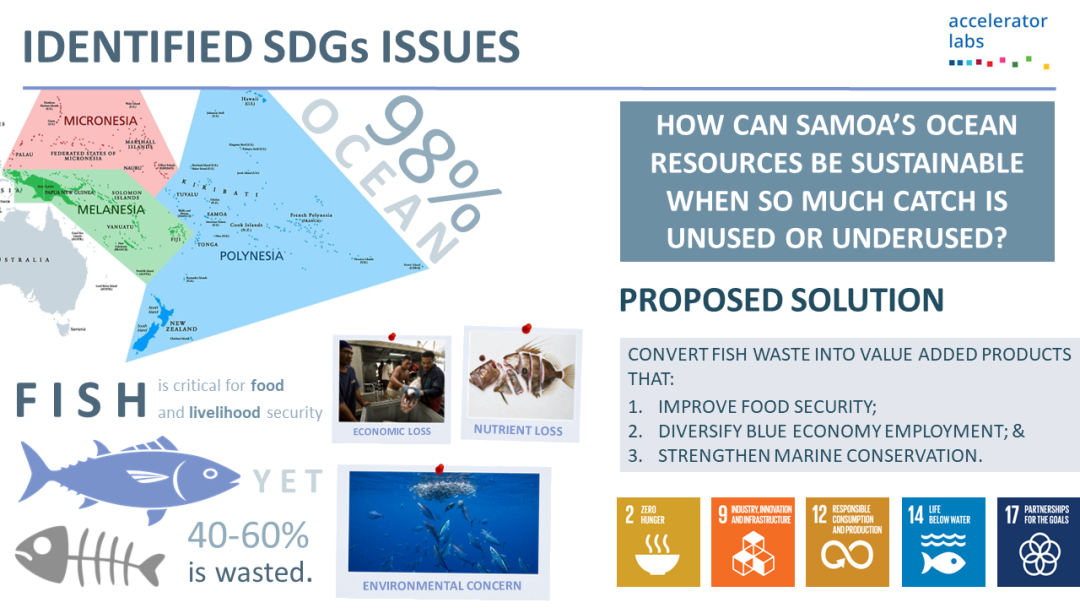Disclaimer:
Please be aware that the content herein has not been peer reviewed. It consists of personal reflections, insights, and learnings of the contributor(s). It may not be exhaustive, nor does it aim to be authoritative knowledge.
Title
Please provide a name for your action learning plan.
100% Fish Use (Japan Innovation Challenge)
Challenge statement
Challenge type: If you are working on multiple challenges, please indicate if this is your "big bet" or "exploratory" challenge.
Please note: we ask you to only submit a maximum of 3 challenges - 1x Big Bet, 2x Exploratory. Each challenge must be submitted individually.
EXPLORATORY
Challenge statement: What is your challenge? (Please answer in specific terms: "Our challenge is that...”.)
Our challenge revolves around devising strategies to establish sustainable economic practices for harnessing Samoa's ocean resources, specifically addressing the untapped potential and underutilization of fish catch.
Background: What is the history of your challenge? What is causing or driving it? Who is involved? How does the current situation look like? What undesired effects does it produce?
Samoa's Ocean Strategy 2020 - 2030 mobilizes an integrated management of its ocean resources for a healthy and abundant future of Samoa's ocean. As such, 30% of Samoa's Exclusive Economic Zone (EEZ) will be converted into a connected system of marine protected areas. This means that a reduction in fish catch and associated revenue of protecting the EEZ. There is now an urgent need to explore strategies on how communities dependent on ocean resources can maximize economic benefits from all caught fish and diversify coastal and ocean dependent livelihoods.
Quantitative evidence: What (official) data sources do you have on this challenge that better exemplifies the importance and urgency of this frontier challenge? You can add text, a link, or a picture.
Qualitative evidence: What weak signals have you recently spotted that characterizes its urgency? Please provide qualitative information that better exemplifies the importance and urgency of this frontier challenge. You can add text, a link, or a picture.
The fishery tuna industry is declining as climate changes impact on the sea increasing temperatures causing migratory tuna to move down to cooler zones. Fish catches decreased from 2,158 mt in 2010 to 1,205 mt in 2014. Tuna export earnings continue to drop from SAT$13.4 million in 2010 to SAT$6.2 million in 2014. Low catch volumes in the fisheries sector has had a devastating impact on returns and forced many small operators from the industry. A lack of scientific data on the issue means that the problem is not well understood, although a number of stakeholders believe that over-fishing is having major impact. Aquaculture is seen to offer a substitute for declining fish catches, and to provide commercial opportunities. However, it will not make up the decline in the offshore fishery. (Situation and Outlook for Samoa Agriculture and Fisheries 2015)
Tuna catch volumes continue to decline and this has resulted in the decline in export volume and value as well. For the last six months of 2014, export volume remained steady at 891 metric tons compared 311 metric tons of the first six months. The continued fluctuation of catches throughout the last five years has not helped in building confidence into the industry resulting in some smaller alia boat owners moving elsewhere because of this. The main factors that may have contributed to the decline in the tuna catches include:
1. Oceanographic conditions – highly variable and if the cold waters are pushed beyond our EEZ zones, la Nina & El Nino occurs. In short, if sea temperatures rise, tuna moves to cooler sea levels.
2. Over-fishing of the main tuna species like albacore in the open waters and nearby EEZ before reaching Samoa EEZ.
3. Cost of operation – the cost of deploying 100 hooks back in 2002 is very much different compared to nowadays. (Situation and Outlook for Samoa Agriculture and Fisheries 2015)
Value proposition: What added value or unique value proposition is your Accelerator Lab bringing to solving this challenge? Why is it your Lab that needs to work on this challenge and not other actors within UNDP, other stakeholders in the country respectively? Why is it worth investing resources to this challenge?
Our value proposition centers on innovatively utilizing 100% fishery resources by turning waste fish skin into fish leather, fostering economic growth through cutting edge technology, diversification and community empowerment. By embracing responsible practices, AccLab aims to provide alternative sustainable solutions in preserving its marine ecosystem while creating economic opportunities.
Short “tweet” summary: We would like to tweet what you are working on, can you summarize your challenge in a maximum of 280 characters?
🌊 Big UNDP Samoa AccLab! are doing something cool—turning leftover fish skin into fancy leather! 🐟👛 Working in partnership with Tototo, local folks and businesses to try it out. Making the world greener and stylish at the same time! 🌍👏 #UNDP #SamoaInnovation #BlueFashion
Partners
Who are your top 5 partners for this challenge? Please submit from MOST to LEAST important and state Name, Sector and a brief description of the (intended) collaboration.
Please state the name of the partner:
1. Think Sea Corp (Tototo Leather) (2) Japan Innovation Unit (3) Youth of Samoa (4) Private Sector (5) Government Stakeholders
What sector does our partner belong to?
Private Sector
Please provide a brief description of the collaboration.
Think Sea Corp is the Japanese company that applied as a solution provider that meets the contextual needs of Samoa. In addition, it is able to provide a low-tech solution of sustainable method of creating value added products from fish waste skin. The collaboration between Think Sea Corp will enable the AccLab to test this proof of concept with interested community and private sector stakeholders.
Is this a new and unusual partner for UNDP?
Yes
Learning questions
Learning question: What is your learning question for this challenge? What do you need to know or understand to work on your challenge statement?
1. How does the process of turning waste fish skin into leather work?
2. What challenges were faced during the prototyping phase?
3. How does involving communities contribute to the success of the project?
4. What role do private sector partners play in making this innovation sustainable?
5. What are the economic implications for local communities involved in this initiative i.e. is it sustainable?
6. What are the potential social and cultural benefits of incorporating local communities in the innovation process?
7. How can the creative and fashion industry adopt and support such environmentally friendly practices on a larger scale?
8. What lessons can be learned from this project for future initiatives aiming to repurpose waste materials?
To what stage(s) in the learning cycle does your learning question relate?
Explore, Test
Usage of methods: Relating to your choice above, how will you use your methods & tools for this learning question? What value do these add in answering your learning question?
Prototyping the proof of concept will allow AccLab to map communities and the private sector that are able to sustain and grow this innovation.
Existing data gaps: Relating to your choice above, what existing gaps in data or information do these new sources of data addressing? What value do these add in answering your learning question?
The leathermaking process requires in-depth knowledge and data to ascertain how it can be a sustainable and viable economic activity that will boost and expand available resources for the creative and fashion industry in Samoa. In addition, there is potential for such a prototype to be scaled into community hubs of fish leather supply chains. It is key to understand not only the leathermaking process itself but how it can upgraded from a low tech process to a more digitally high tech process.
Closing
Early leads to grow: Think about the possible grow phase for this challenge - who might benefit from your work on this challenge or who might be the champions in your country that you should inform or collaborate with early on to help you grow this challenge?
The growth phase of this innovative challenge is the scaling of the leathermaking process to select community hubs and interested private sector stakeholders. In particular, the private sector stakeholders will be key in creating an enabling environment for the manufacturing aspect of the leathermaking process.
END OF ACTION LEARNING PLAN: Thank you! The form saves automatically and your submission has been recorded. You may now exit this window.



 2Zero hunger
2Zero hunger 12Responsible consumption and production
12Responsible consumption and production 14Life below water
14Life below water
Comments
Log in to add a comment or reply.